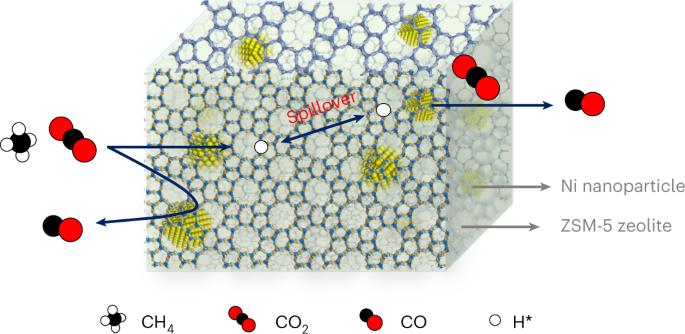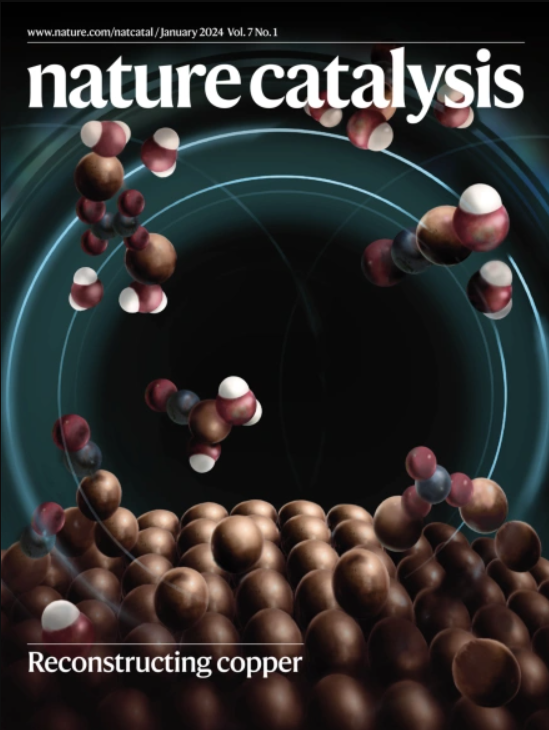Enhanced CO2 utilization in dry reforming of methane achieved through nickel-mediated hydrogen spillover in zeolite crystals
IF 44.6
1区 化学
Q1 CHEMISTRY, PHYSICAL
引用次数: 25
Abstract
Transformation of CO2 into precursors for chemicals and fuels by self-contained reducing gas contaminants (for example, CH4) is attractive from a carbon economy perspective. Reducing as much CO2 as possible using a limited amount of reducing gas would be ideal, but general dry reforming (DRM) schemes consume stoichiometric amounts of methane for CO2 reduction. Here we develop a process with high reducibility of methane relative to conventional DRM, using up to 2.9 mol of CO2 per mol of CH4. Key to this success are Ni nanoparticles, fixed within the matrix of an aluminosilicate zeolite catalyst (Ni@HZSM-5), that enhance hydrogen spillover to favour the reduction of CO2. This process achieves an energy cost for reducing CO2 of 113.6 kJ per mol CO2, which is 31.9% lower than the conventional DRM process with stoichiometric transformation of CO2 and methane. In addition, the rigid zeolite framework could minimize coke formation and prevent Ni sintering. Carbon dioxide reforming can be used to valorize hydrocarbon-containing CO2 streams without the use of external reductants, but existing methods remain inefficient. Here, an HZSM-5-encapsulated nickel catalyst is introduced that features a remarkable methane dry reforming activity combined with high methane utilization.

通过镍介导的沸石晶体中的氢溢出提高甲烷干重整中CO2的利用率
从碳经济的角度来看,利用自带的还原性气体污染物(如甲烷)将二氧化碳转化为化学品和燃料的前体是很有吸引力的。使用有限的还原气体尽可能多地还原二氧化碳是最理想的,但一般的干重整(DRM)方案需要消耗一定量的甲烷来还原二氧化碳。在这里,我们开发了一种与传统 DRM 相比具有较高甲烷还原性的工艺,每摩尔 CH4 可使用多达 2.9 摩尔 CO2。成功的关键在于固定在铝硅酸盐沸石催化剂(Ni@HZSM-5)基质中的镍纳米颗粒,它能增强氢的溢出,从而有利于二氧化碳的还原。该工艺还原二氧化碳的能量成本为 113.6 千焦/摩尔二氧化碳,比二氧化碳和甲烷按化学计量转化的传统 DRM 工艺低 31.9%。此外,刚性沸石框架可最大限度地减少焦炭的形成并防止镍烧结。二氧化碳重整可用于在不使用外部还原剂的情况下对含碳氢化合物的二氧化碳流进行增值,但现有的方法仍然效率低下。这里介绍的 HZSM-5 包封镍催化剂具有显著的甲烷干重整活性和较高的甲烷利用率。
本文章由计算机程序翻译,如有差异,请以英文原文为准。
求助全文
约1分钟内获得全文
求助全文
来源期刊

Nature Catalysis
Chemical Engineering-Bioengineering
CiteScore
52.10
自引率
1.10%
发文量
140
期刊介绍:
Nature Catalysis serves as a platform for researchers across chemistry and related fields, focusing on homogeneous catalysis, heterogeneous catalysis, and biocatalysts, encompassing both fundamental and applied studies. With a particular emphasis on advancing sustainable industries and processes, the journal provides comprehensive coverage of catalysis research, appealing to scientists, engineers, and researchers in academia and industry.
Maintaining the high standards of the Nature brand, Nature Catalysis boasts a dedicated team of professional editors, rigorous peer-review processes, and swift publication times, ensuring editorial independence and quality. The journal publishes work spanning heterogeneous catalysis, homogeneous catalysis, and biocatalysis, covering areas such as catalytic synthesis, mechanisms, characterization, computational studies, nanoparticle catalysis, electrocatalysis, photocatalysis, environmental catalysis, asymmetric catalysis, and various forms of organocatalysis.
 求助内容:
求助内容: 应助结果提醒方式:
应助结果提醒方式:


